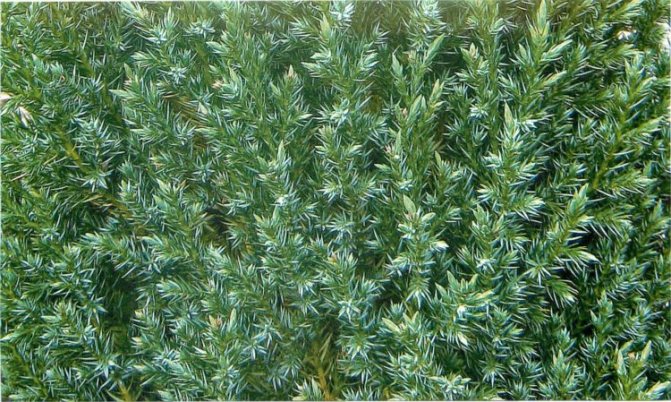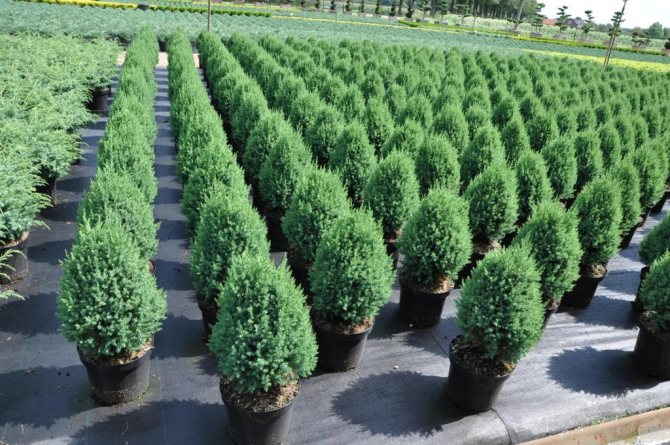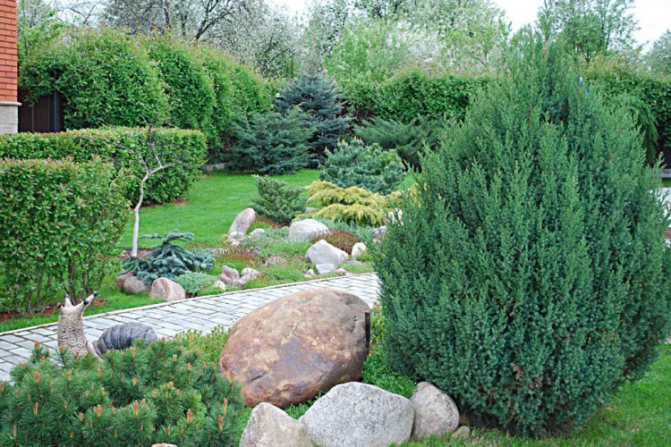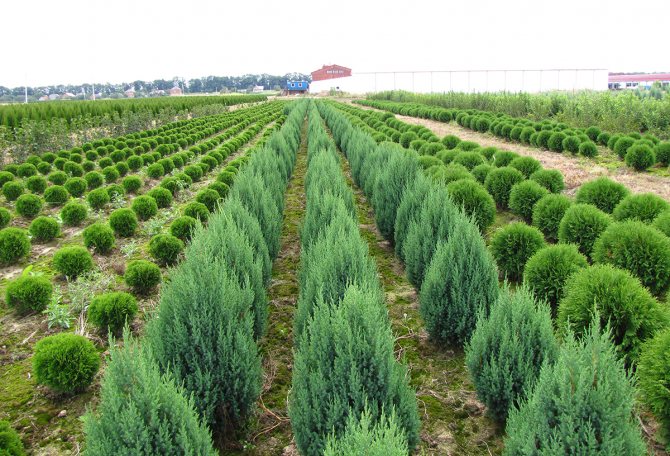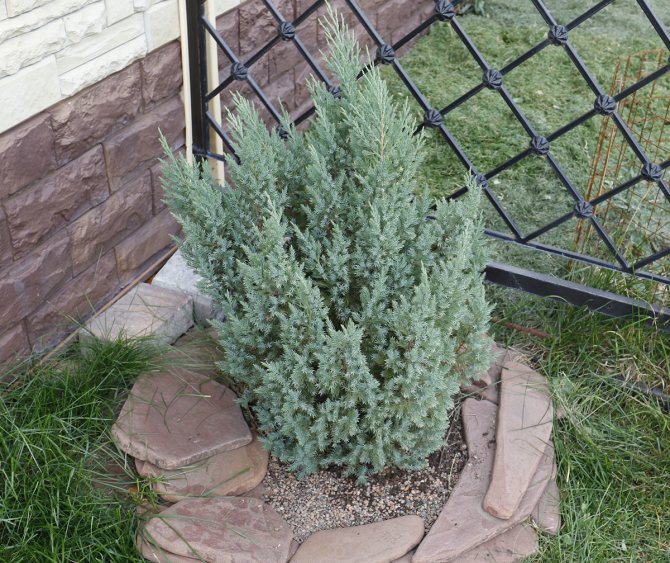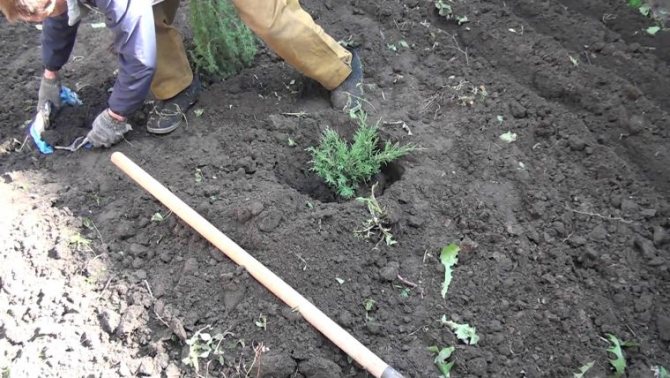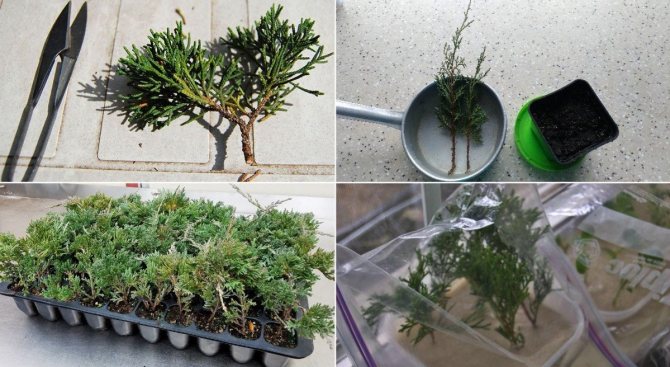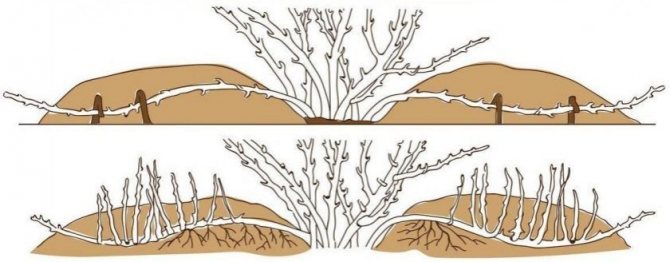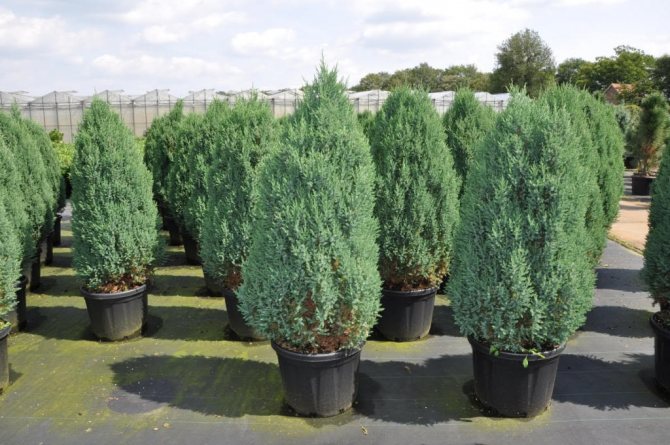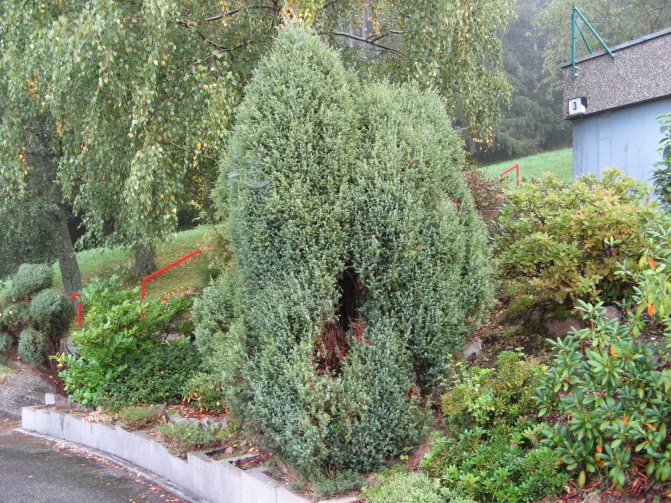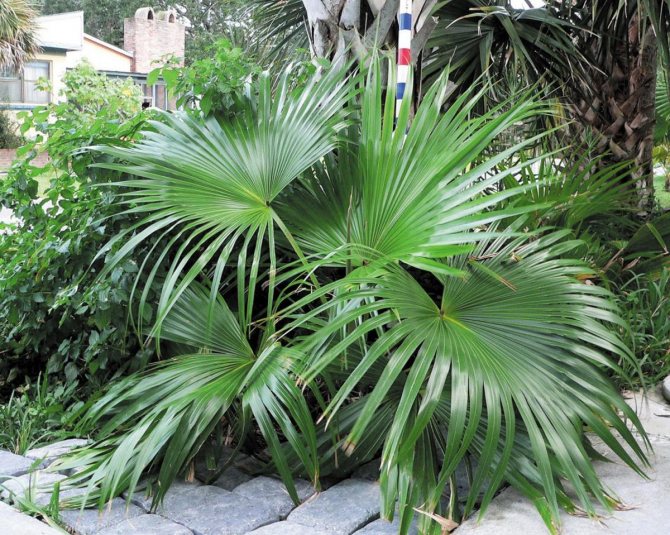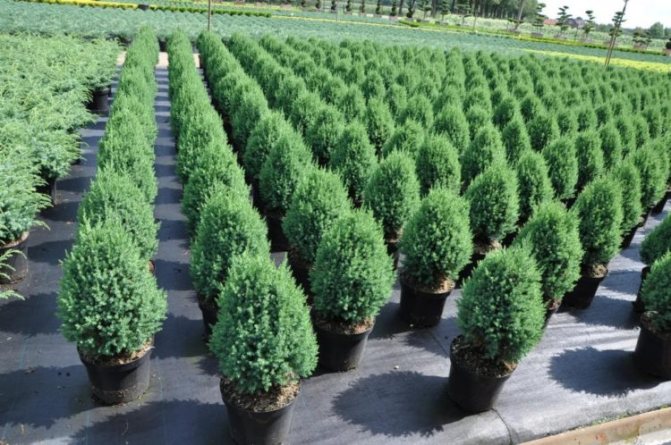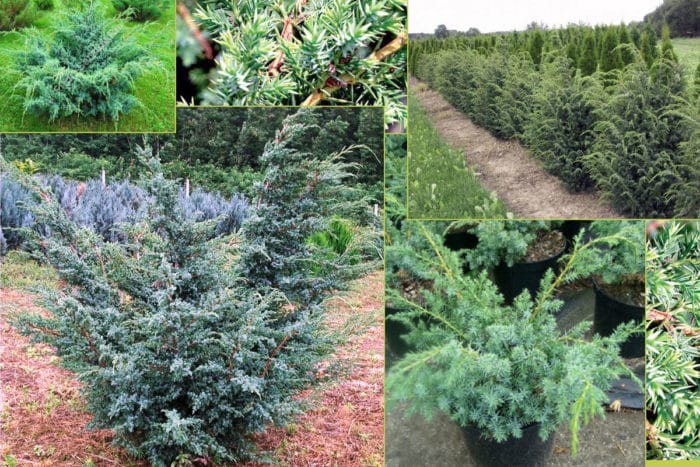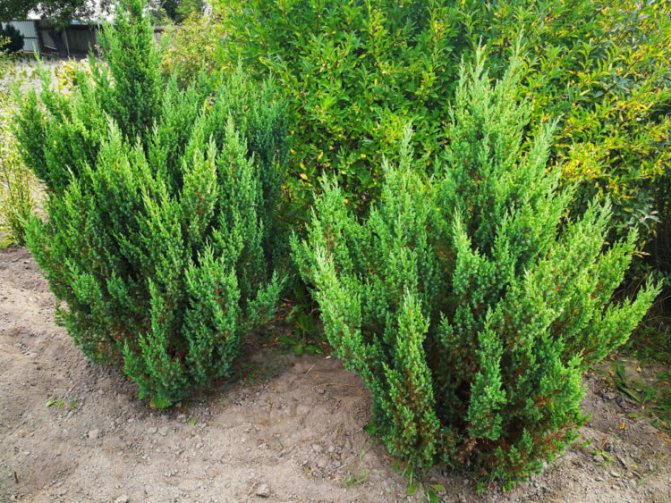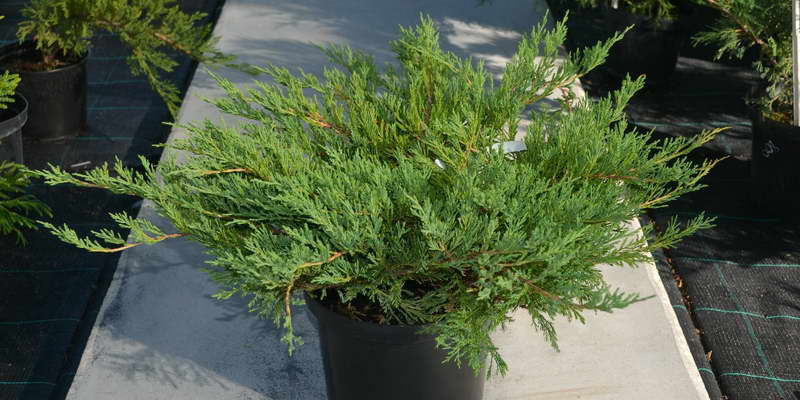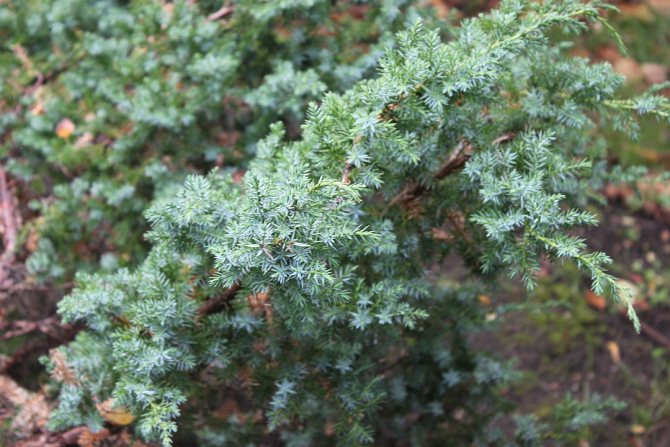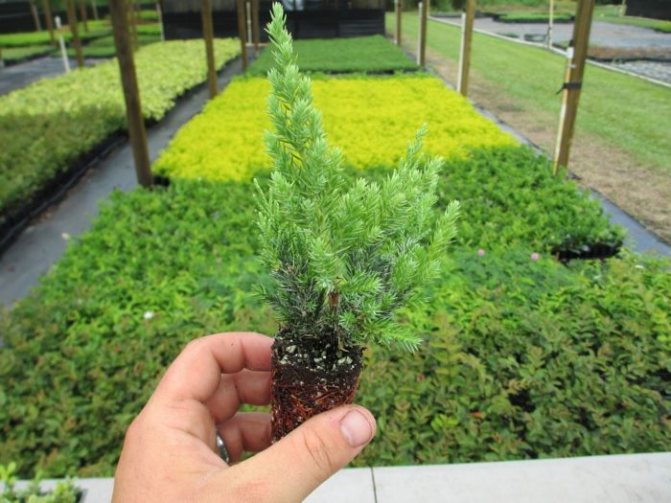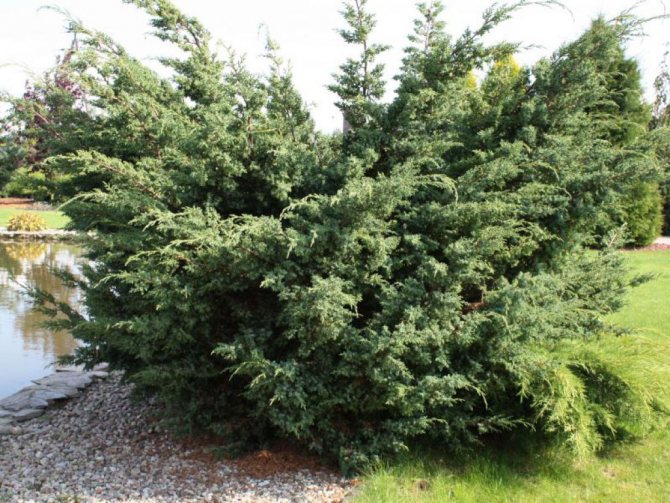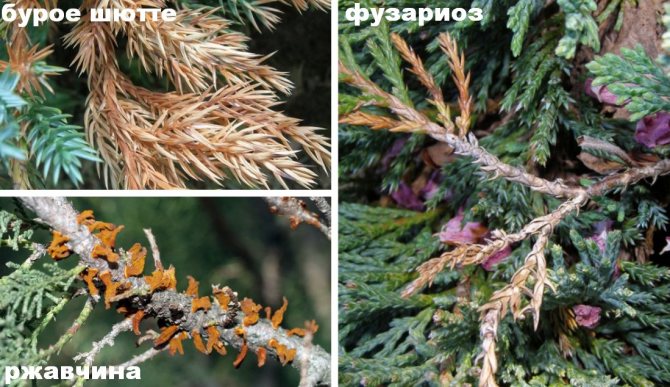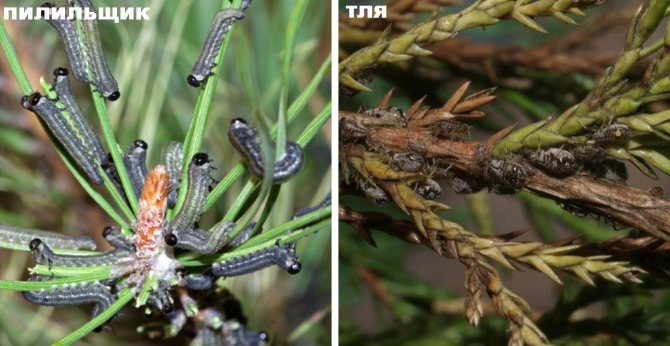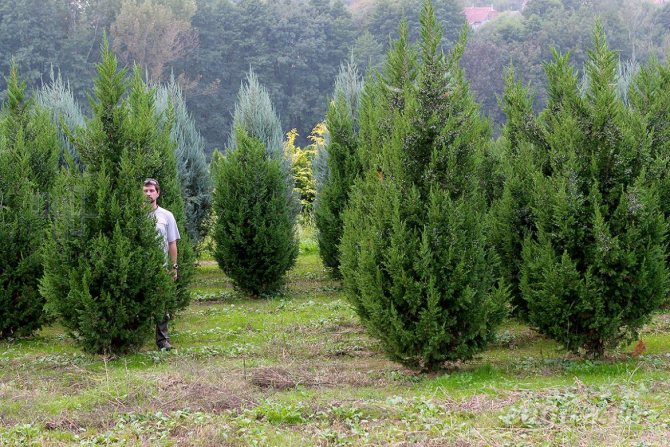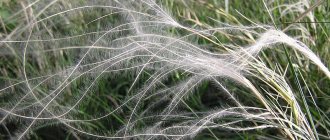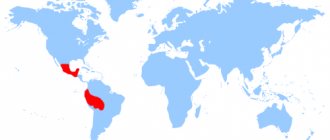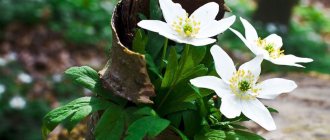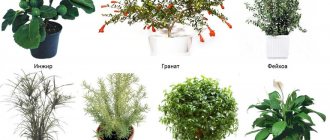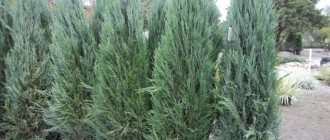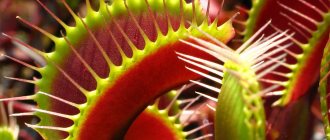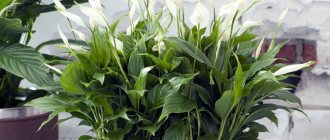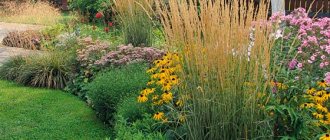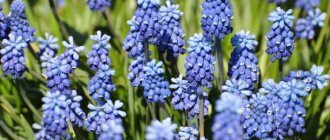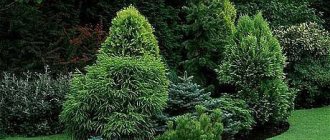In the natural variety of juniper varieties, gardeners - breeders have made changes and supplemented the list of plants with new varieties of decorative ephedra. Juniper Strickta is one of these artificially bred varieties. He conquered gardeners all over the world with its unpretentiousness and attractive appearance. Blue-green "cones" of juniper bring solemnity and grandeur to the decoration of the site.
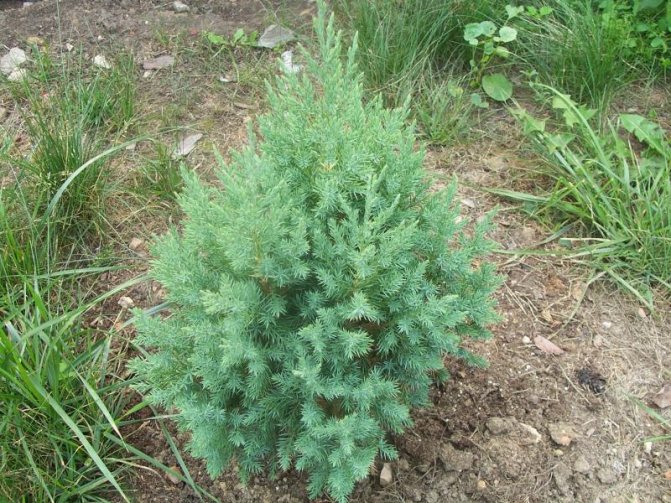
Juniper chinese
Chinese juniper (Juniperus chinensis) is a tree, usually with a columnar or pyramidal crown, in nature up to 10 m or more in height. The bark is grayish-red, flaking. The crown is pyramidal. Young shoots are dark green, round-tetrahedral, about 1 mm thick. The needles are green, mostly scaly, 1.5-3 mm long, tightly pressed, with a piece of iron on the back. Juvenile needles are found in young plants and on old shoots, they are acicular, up to 12 mm long, protruding, from the inside with two white stomatal stripes, prickly. The cones are dark blue, almost black with a bluish bloom, 4-10 mm in diameter, 4-8 scales with 2-3 seeds.
Juniper Chinese grows in nature in China, Korea, Japan. In culture until 1767
It retains its decorative properties better on fertile, moderately moist soil.
Preparing for winter
Often, the juniper tolerates wintering normally. With age, its frost resistance only increases. However, young plants are the least resistant to cold.
Plants weakened after a hot summer and some thermophilic varieties also require insulation. At the end of autumn, at the base of the trunk, the shrub must be sprinkled with peat. After it is supposed to cover with spruce branches.
In March, to avoid rotting, the peat should be removed. In winter, during heavy snowfalls, the crown of some species deteriorates. To avoid this, proper measures should be taken. Snow should be regularly removed from the crown.
You can also tie it in the fall. It must be remembered that the sun's rays are an additional threat, which contributes to the dehydration of junipers in winter. That is why abundant watering is necessary in the fall.
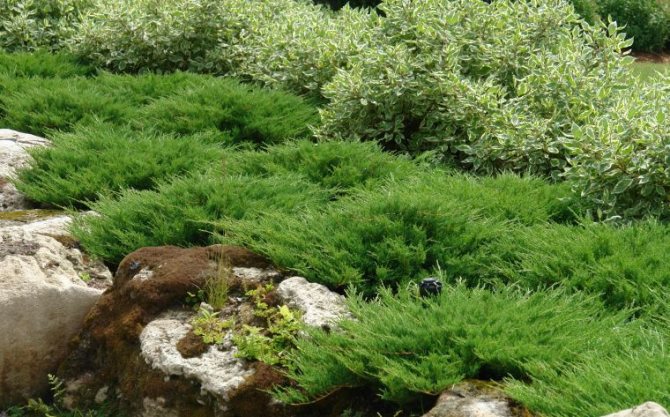

ul
Chinese juniper varieties and their photos
In total, there are about 50 varieties of Chinese juniper. Also, this species is often attributed to its hybrid varieties with M. Cossack, which are better attributed to the forms of M. Fitzer (J.pfitzeriana).
A variety of Chinese juniper ‘Blaauw’ (‘Blaauw’s Variety’, J. x media ‘Blaauw’, J. x pfitzeriana ‘Blaauw’) (1924, Japan). Shrub up to 2 m in height and 1.5 m in width. Similar to ‘Plumosa’, but needles are greyish-blue. With age, it becomes columnar.
Juniper variety ‘Expansa’ (‘Parsonsii’) (until 1938, USA). A low, flat shrub with strong and rough open branches. Branches and shoots of the Chinese ‘Expansa’ juniper, obliquely ascending, dense, short. The needles are of two types, mainly needle-shaped, bluish.
Cultivar ‘Expansa Aureospicata’ (‘Expansa Aureovariegata’, ‘Aureospicata’, J. davurica ‘Expansa Aureospicata’) (1938). 'Expansa' crown shape. The height is not more than 0.5 m. The needles are acicular, somewhat protruding, mostly bluish-green, on individual shoots and areas of branches - light yellow.
'Keteleeri' (until 1910). Female clone. Dense columnar shape up to 5 (10) m in height, with a long pointed tip. The branches are raised. Twigs and shoots are dense, spread out in all directions. The needles are pure green, of two types, but mostly scale-like. Bears abundant fruit, cones with a white bloom.
Juniper Chinese ‘Plumosa’ (J. x media ‘Plumosa’). (1900-1910, Japan). Male clone. As you can see in the photo, the Chinese ‘Plumosa’ juniper is a low, up to 1.5 m, bushy tree with a short, inclined main trunk and arched open branches. Lateral branches and short shoots are short, drooping at the ends.The needles are mostly scaly, dark green.
Cultivar ‘Plumosa Albovariegata’ (‘Alba’, J. japonica ‘Albovariegata’, J. x media ‘Plumosa Albovariegata’) (1847, Holland). Lower, up to 1 m in height. The needles are scaly, bluish-green, white at the ends of individual shoots and twigs.
Cultivars ‘Plumosa Aurea’ (J. chinensis f. Aureoglobosa, ‘Bandai-sugi Aurea’, J. japonica ‘Aurea’, J. x media ‘Plumosa Aurea’, J. virginalis globosa ‘Yellow’) (1885, England). The shape is typical 'Plumosa', but the height is up to 1 m. The needles are golden-yellow, especially bright in spring, bronze in winter. In the photo gallery you can see photos of Chinese juniper suitable for growing bonsai, including the ‘Plumosa Aurea’ variety.
Cultivars ‘Plumosa Aureovariegata’ (J. japonica ‘Argenteovariegata’, J. japonica ‘Aureovariegata’, J. x media ‘Plumosa Aureovariegata’). Shape like ‘Plumosa Albovariegata’, but the needles at the ends of the shoots are yellow.
Variety 'Variegata' ('Stricta Variegata'). Similar to 'Stricta' in crown shape and main color of needles, but individual branches are creamy.
Juniper Chinese "Blue Alps"
Juniper Chinese 'Blue Alps' ('Blue Mountain', J. squamata 'Blue Alps') was bred in Austria in 1968. It is a powerful shrub up to 2.5 (4) m tall. long, with drooping ends, the same lateral branches and shoots. Needles are acicular, up to 1 cm long, strongly protruding, tough and prickly. The color is bluish-green, the bottom is silvery. Subject to sunburn.
Juniper Chinese 'Expansa Variegata'
Juniper Chinese ‘Expansa Variegata’ (‘Parsonsii Variegata’, J. davurica ‘Expansa Variegata’, J. squamata ‘Albo-variegata’) was bred in 1938. The shape of the bush is similar to 'Expansa'. There are twigs and shoots with scaly needles. The needles are mostly green, in some parts of the branches - light cream.
Juniper Chinese "Obelisk"
Juniper Chinese "Obelisk" (‘Obelisk’) was cultivated in 1930 in Holland. It has a narrow columnar shape, grows slowly, at the age of 20 it reaches 3 m in height. Skeletal branches are short, strong, open. Twigs and shoots are dense, short. The needles are acicular, protruding, green, with silvery stomatal stripes below, which gives it a bluish tint.
Juniper Chinese 'Kuriwao Gold'
Juniper Chinese ‘Kuriwao Gold’ (J. x media ‘Kuriwao Gold’, J. x pfitzeriana ‘Kuriwao Gold’) is a wide and loose shrub with strong, semi-lying, variously directed skeletal branches. Twigs and shoots obliquely ascending, spaced apart, their ends do not droop. The needles are of two types, with transitional forms. Young shoots with needles are yellowish, with light yellow ends, old needles are green.
Juniper Chinese "Spartan"
Juniper Chinese "Spartan" ('Spartan' ('Helle', J. virginiana 'Helle', J. virginiana 'Spartan') grown in 1960 in the USA A tree with a dense columnar or fusiform crown up to 6 m tall. Skeletal branches are raised. Lateral branches and shoots are ascending and upright.The needles are pure green, mostly scaly, tightly pressed, on some of the shoots there are acicular, protruding needles.
Juniper Chinese "Strikta"
Juniper Chinese "Stricta" (‘Stricta’, ‘Pyramidalis’, J. squamata ‘Campbellii’) was bred in 1945 in Holland. Narrow-pyramidal with a sharp tip, dense. Skeletal branches are raised, dense. The needles are needle-shaped, bluish-green, silvery underneath. Brownish in winter.
Varieties
| Variety name | Height, m | Needle color | Crown shape |
| Medium-sized shrubs | |||
| Plumosa alboriegata | 1 | bluish green | spreading, feather-like |
| Blaauw | 2 | gray-bluish | spreading, feather-like |
| Plumosa aurea | 1 | yellow-golden | broad |
| Globosa cinerea | 2 | gray-bluish | spreading, feather-like |
| Plumosa tremonia | 2 | yellow-golden | strict, straight |
| Obelisk | 3 | green-blue | wide, irregular-columnar |
| Pendula | 1 | gray-green | loose, drooping |
| Japonica | 2 | green | creeping or wide pin-shaped |
| Kaizuka | 3-4 | green | unevenly spaced |
| Stricta | 2,5 | bluish green | narrow-pitched, acute |
| Plumosa | 1-1,5 | green | oblique |
| Fairview | 3 | light green | narrow-pitched |
| Kuriwao gold | 2-3 | golden, green | wide, spreading |
| Tall shrubs | |||
| Columnaris | 8 | green | loose, columnar |
| Columnaris glauca | 8 | silver gray | columnar |
| Ketelerii | 10 | green, bluish | columnar, tight-gored |
| Mountbatten | 4 | gray-green | narrow-size, columnar |
| Neaborensssis | 4-5 | silvery green, bluish green | columnar |
| Creeping shrubs | |||
| Pfitzeriana | 3 | light green | wide, spreading |
| Mint-Julep | 1 | light green | wide, arcuate-curved |
| Blue cloud | 1 | steel bluish | broad, slow-growing |
| Armstrongii | 1,2 | gray-blue, gray-green | broad, slow-growing |
| Pfitzeriana compacta | 0,3-0,5 | light green | squat, flat |
| Var. sargentii | 0,5-0,8 | bluish green | creeping |
| Expansa | 0,5 | light blue | elevated |
| Expansa variegata | 0.4 | blue-green with cream touches | wide, spreading |
| Old gold | 2 | golden green, yellow | outstretched |
| Gold coast | 1 | golden yellow | wide, flat, slow-growing |
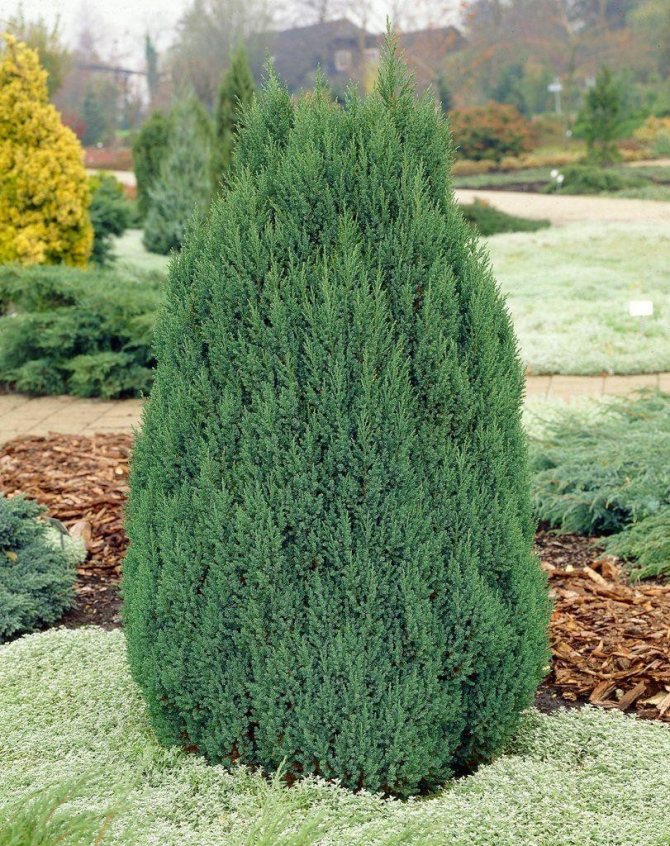

Juniper strict
Juniper Chinese: features of the species
The Chinese juniper is a plant species of the Cypress family, which is native to China, Manchuria, Japan and North Korea. The plant is a shrub or tree up to 20 m high, the shoots are colored dark green. The Chinese variety of juniper has two types of needles: acicular and scaly.
Read also: How to choose an inexpensive and reliable cultivator for summer cottages, video
Chinese juniper was introduced to Europe in the early 19th century. In the CIS, this plant first appeared in the Nikitsky Botanical Garden in 1850.
Juniper can withstand frosts down to -30 ˚С. However, in the first years after planting, frost resistance is very low, which should be remembered when sheltering for the winter.
The plant is not demanding on the fertility of the soil and its moisture, however, it begins to hurt when the air humidity is low.
Chinese juniper can be planted in the following zones: the southwestern part of the forest zone, the western and central part of the forest-steppe and steppe zones of the CIS. Juniper grows best in the Crimea and the Caucasus.
We pass on to the description of the first variety of Chinese juniper in our list - "Strekt".
Variety "Strikta" is a shrub with a conical crown and dense branches that are directed upwards. The maximum height of the shrub is 2.5 m, the diameter of the crown is 1.5 m. The juniper is colored greenish-blue, which does not change throughout the year. "Stricta" grows very slowly, adding 20 cm per year. The plant is long-lived and can survive for about 100 years. This variety is undemanding to moisture and soil fertility, but it is very photophilous and requires long daylight hours. Planting is possible only in an open place, shade or partial shade will not work.
Variety "Strickta" can be affected by such pests: scale insects, scale insects, juniper sawfly and aphids. The shrub is used both for single planting and for group planting. Having planted several plants at the border of the site, after 10 years you can observe a dense green hedge, which perfectly protects against dust and noise, and due to the release of phytoncides - from pests.
Gardeners recommend planting the plant on rocky soils, since it is impossible to grow fruits or vegetables on such a substrate. Juniper is also grown in containers, which is very suitable for those who want to take a "green friend" into the house for the winter.
Juniper Chinese "Blue Alps" is an evergreen tree that grows up to 4 m in height and 2 m in diameter. The plant is colored green-blue (the lower branches are gray-silvery), the needles are represented by thorny needles.
"Blue Alps" has the correct wide-pyramidal shape, which over time turns into a vase-like shape.
Junipers are provided with a good root system, which helps them to stay in rocky ground. You can plant a tree in infertile soil, but the place should be open, with good lighting. An important factor is the acidity of the soil, which should be either neutral or slightly acidic.
Juniper "Blue Alps" is frost-resistant. However, in the first years of life, it requires shelter for the winter.
Gardeners advise planting Blue Alps along with rose bushes.This tandem looks very impressive, and neighboring plants do not interfere with each other.
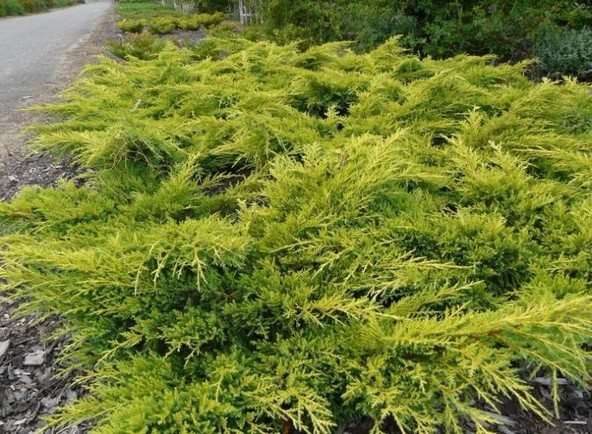

Juniper Chinese "Gold Star" - a dwarf shrub with a spreading crown. The maximum plant height - 1 m, in diameter - up to 2.5 m. "Gold Star" has shoots of yellow-golden color, and the needles themselves are painted in yellow-salad color. The needles are not prickly, needle-like or scaly.
A mini-shrub from a distance resembles a hedgehog with long needles. The density of the needles is so high that it is very difficult to see the trunk or shoots.
This variety, like those described above, is not picky about the soil and watering, but without the sun's heat, alas, it will hurt.
"Gold Star" can infect such pests: juniper miner moth, spider mite and juniper scale insect. Many parasites are caused by improper care or poor lighting.
The plant can be used both for garden decoration and for growing at home. Although a dwarf juniper grows a sprawling crown, with proper pruning, you can turn it into a fluffy ball that will delight you and your guests.
Gardeners recommend planting Gold Star on a lawn that will highlight and accentuate a small bush.
Where and how it grows, conditions
The ancestral home of such a wonderful plant as the Strickt juniper (a juniper often called simply "Chinese") is, as you might guess, China, in particular, its northeastern and eastern parts. Although, equally, this type of juniper is not only Chinese, but also Japanese, and even Mongolian, since in these countries its "ancestors" grow everywhere.
But, interestingly, the variety itself was bred in Europe in the middle of the twentieth century by Dutch scientists, as adapted to local environmental conditions.
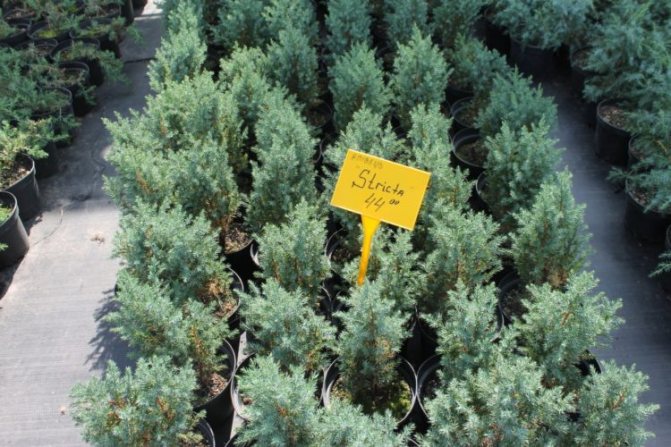

Juniper Strickta is not a very whimsical plant. Loves:
- heat;
- moisture;
- abundant watering.
Tolerantly refers to:
- to any soil;
- to frost.
- to polluted air.
Does not tolerate:
- darkness, thick shadow;
- dry air.
Interesting facts about the variety
- Juniper Strickt with proper care can live for more than 100-120 years.
- The bush propagates by cuttings, but it is unlikely that it will be possible to grow a tree from the seeds.
- It grows very slowly: in a year it adds about 15 cm maximum.
"Expansa Variegata"
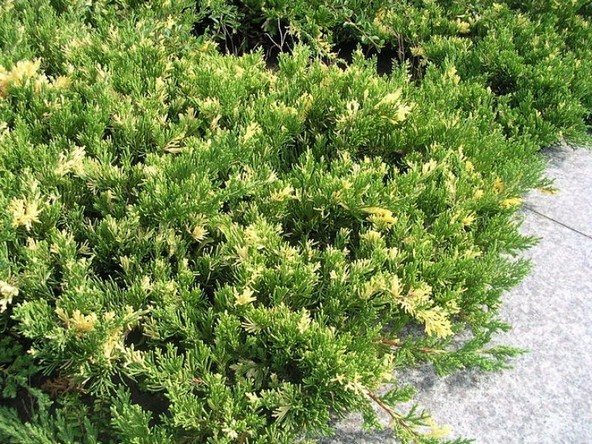

Juniper Chinese "Expansa Variagata" is a dwarf shrub that has a maximum height of 40 cm and a width of about 1.5 m.
If you had not been told that this plant is a juniper, then you would not have guessed. The fact is that the shoots of this variety do not grow up, but spread along the ground, turning into a green needle carpet.
The needles are colored green-blue and consist of needles or scales. Fruits are represented by small (5-7 mm) light green cones.
Expansa Variegata is used in Japanese gardens. The plant is planted, like other types of juniper, on stony, nutrient-poor soil.
It should be said right away that this variety is not recommended to be planted in the house. The plant loves to creep along the ground, so either plant it in your garden plot, or buy a very wide pot.
Juniper Chinese "Spartan" is a fast-growing tree with a conical crown. The plant at the age of ten reaches a height of 3 m, which makes it possible to use it as a hedge.
The maximum tree height is 5 m, the crown diameter is 2.5 m. The tree shoots are located vertically. The branches grow so fast that they grow 15 cm in length in one season. The needles are dense, light green, represented by needles.
"Spartan" is planted on soils with moderate moisture. The plant is frost-resistant, undemanding to the composition of the soil, photophilous.
Gardeners recommend using the tree for hedging and in group compositions with lower plants.
Harm and contraindications
Few people know that almost all junipers are actually poisonous plants. Only a few species of juniper are used in medicine to fight colds, treat skin rashes and radiculitis. Unfortunately, Strickt's juniper is not one of them. Although it would be more accurate to say this: a set of useful substances is present, but the fruits contain toxic substances and cannot be collected, consumed or treated with them!
Important! Make sure that children or animals do not play or take the needles and fruits of the Strict Juniper in their mouths, as these parts of the plant contain poison! Juniper should not be planted near institutions where children of primary school and preschool age study.
"Kurivao Gold"
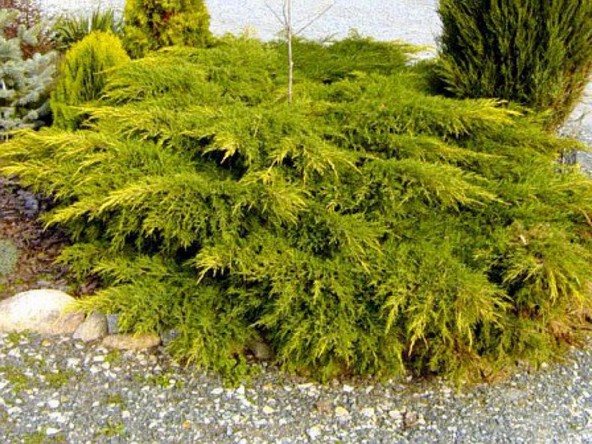

The "Kurivao Gold" variety is a spreading shrub with a wide crown. The maximum plant height is 2 m, the diameter is the same. Thus, the bush turns out to be almost square due to the growing shoots perpendicular (to the trunk).
Young shoots are golden in color. Over time, the needles (scaly) darken, acquiring a bright green color.
Fruits are cones, which are dull green at the initial stage. Ripe fruits are black with a whitish bloom.
The plant looks great on lawns in the form of center figures. Most often, this variety is used in landscape design, less often - it is planted in a pot and grown in the house.
Read also: Budra - outdoor and home care
Like other Chinese junipers, Kurivao Gold does well in poor soil and dry soil. It is worth protecting the bush from direct sunlight (slightly shading) and through wind.
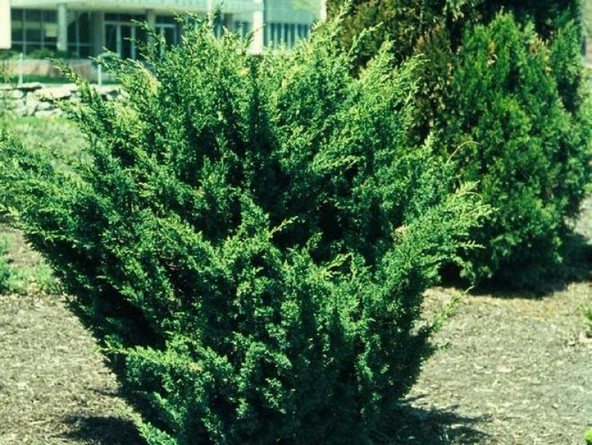

Juniper Chinese "Blau" is an evergreen slow-growing shrub that has a crown shape. This variety was introduced to Europe only in the 1920s from Japan. The plant has traditionally been used to decorate Japanese gardens and as an element of ikebana.
The shrub is characterized by straight shoots that grow straight upward, which determines the shape of the shrub. The maximum height of the juniper is 2.5 m, the diameter is 2 m. The annual growth is only 10 cm in height and 5 cm in width. The plant lives up to 100 years. These are average values that depend on the moisture and fertility of the soil.
The needles of the bush consists of scales, painted in a gray-blue color.
Almost any soil with a neutral or slightly acidic reaction is suitable for the "Blau" variety. However, many gardeners have noted that the shrub thrives in alkaline soils.
The variety is suitable for planting on busy city streets. Does not get sick due to air pollution and toxic emissions.
"Blau" is affected by the only pest - the sawfly.
It is recommended to plant junipers in tandem with tall ornamental crops, placing the plants so that the Blau is in partial shade.
Care
Black elderberry Black Beauty: description and characteristics of the variety
The plant will not require a lot of time from the owner of the site. Crop care is not time consuming. Among the main events:
- Watering;
- Weeding;
- Mulching;
- Top dressing;
- Pruning;
- Pest and disease control.
Watering, weeding and mulching
Juniper Cossack Variegata calmly tolerates drought, but to accelerate growth, it is watered once every 30 days. It is allowed to irrigate the shrub with clean warm water every week from a spray bottle. But it is recommended to do this after sunset. After watering, the land under the bush is weeded and mulched with dry leaves, peat, sawdust.
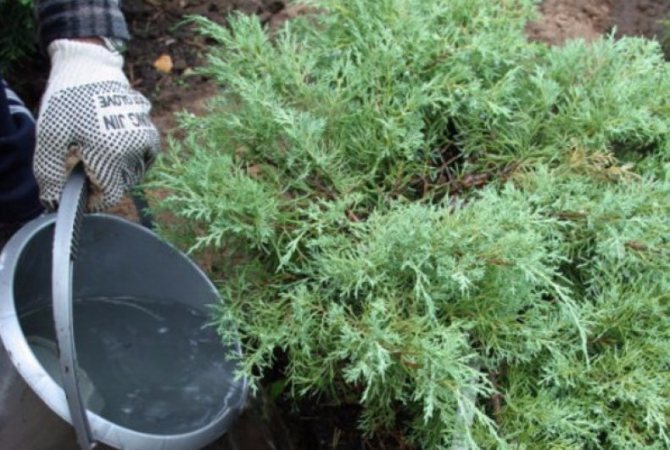

Watering the juniper
Top dressing
One or two additional fertilizing a year is enough for a culture. The procedures are performed at the very beginning and at the end of spring. A nitroammophoska is placed under the bush. Another good universal fertilizer is Kemira.
Pruning
The variety tolerates pruning well. But here it is important for the gardener not to overdo it. The first 3 years after planting, the juniper is only slightly trimmed. Only old and dried branches are removed. After 3 years spent on the site, the plant is allowed to give the shape that the landscape designer intended.
Fighting ailments and insects
The disease to which the variety is susceptible is brown snow mold (Schütte brown). Fallen needles are burned, damaged shoots are cut off. The plant is sprayed with Bordeaux liquid.
The plant can become infected with rust, which comes from rowan or pear. As a preventive measure, Cossack juniper Variegata is planted away from these trees. If rust is already noticeable, then all damaged shoots are removed from the bush. After it is treated with Topaz. This remedy is used twice a season.
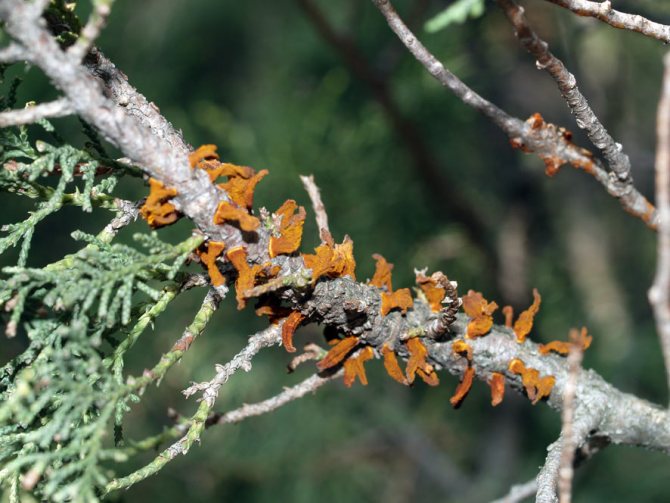

Rust on juniper
Insects do not like the smell of juniper, so they rarely attack an elegant shrub. However, it does happen. The most courageous pest that is not afraid to attack the representative of Cypress is the spider mite. To combat it, acaricides are used:
- Anti-mite;
- Neoron;
- Apollo;
- Fitoverm;
- Omite, etc.
Another pest that spoils juniper is ants. These insects carry other parasites on themselves, for example, aphids, worms. As soon as the gardener saw the ants crawling through the crop, he immediately sprinkles the bush with Thunder, Ant, Fufanon.
Additional Information. Protect the landing from pets. Waste from cats and dogs ruins the plant.
"Plumosa Aurea"
The variety "Plumosa Aurea" is a dwarf evergreen shrub with feathery shoots. The plant is very effective, with proper care it becomes the "queen" of the ornamental garden.
The maximum height of the juniper is 2 m, the diameter of the crown is 3 m. Unlike the varieties described above, Plumosa Aurea does not form dense needles, therefore, it will not work to create a semblance of a ball from its shoots and green cover.
This variety can be classified as fast-growing, since even with minimal care for one year, the plant becomes 20-25 cm taller and 25-30 cm wider.In the tenth year, the juniper has a height of 1 meter and a crown diameter of about 1.5 m.
The needles of "Plumosa" are colored golden-yellow, very soft, and consist of small scales.
The plant prefers a well-lit place. If the juniper does not have enough light, then its needles begin to change color and turn green.
It is traditionally possible to grow the variety on any soil, however, if you want fast growth and rich color, then it is better to choose a more fertile soil and constantly monitor its moisture.
Gardeners recommend planting this variety in large parks or squares. Juniper does well in containers.
Do not forget that unpretentious shrubs require pruning and minimal protection from diseases and pests.
Juniper Chinese "Monarch" - a tall tree with an irregular columnar shape. The plant is quite tall, monochromatic, with dense needles.
The plant grows very slowly, but it is worth remembering that the maximum height of this giant can exceed 3 meters in height and 2.5 m in width. To use this variety, as you already understood, is best for green hedges or as a centerpiece in the garden.
The needles of "Monarch" are prickly, painted in bluish-green color. From a distance, the tree seems completely blue.
Junipers can be planted both in a sunny place and in partial shade. It is undemanding to soil and watering, but it is not worth planting in a draft so that the plant does not "acquire" parasites or various diseases.
If you decide to plant some new plants in your garden, then the juniper will be very useful.This plant perfectly collects dust, delimits the territory, purifies the air and saturates it with phytoncides, which kill pathogenic bacteria and viruses. We told you about the Chinese juniper, described several varieties that are easiest to find in nurseries and plant on a personal plot.
Characteristic features of culture
- Juniper is an evergreen coniferous plant. This is a representative of the huge Cypress family. The popular name of the culture is Veres.
- Depending on the species, junipers are both shrubs and trees. There are dwarf junipers in the form of carpets creeping on the soil, as well as trees with a 20-meter trunk and towering above the ground.
- The twigs of the plant look unusual. They are decorated with leaves, pleasant to the touch, in the form of needles or needles, covered with miniature scales.
- A distinctive feature of the plant is a pleasant spruce-resinous smell.
- The culture releases volatile substances - phytoncides. They have antimicrobial properties and disinfect the air. At the same time, heather releases phytoncides much more than other conifers.
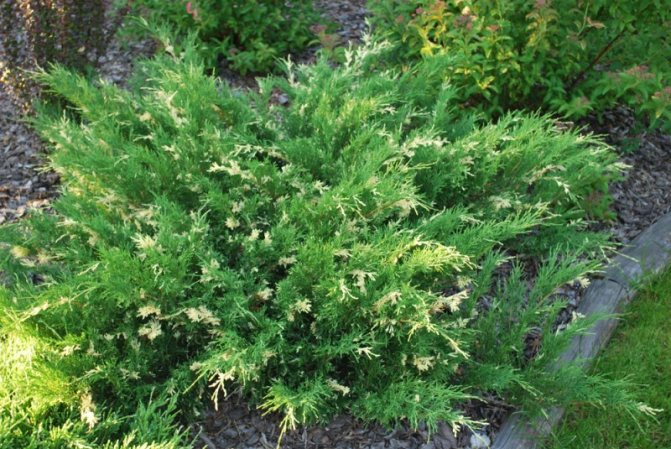

Juniper variegata
- The plant is not afraid of cold weather. In nature, it grows mainly in the area of the Northern Hemisphere.
- Veres is a long-liver. It can develop over hundreds of years.
- Juniper is an indispensable element in garden decoration.
- In gardening, culture is unpretentious. Even a novice gardener can grow a juniper bush or tree.
- The characteristic of heres indicates that most often it is grown in an open area, in apartments it is uncomfortable.
Juniper Chinese: varieties "Spartan", "Monarch", "Strikta", "Variegata" + photo
If you don't already have Chinese junipers in your garden, you should take a closer look at the numerous varieties of coniferous shrubs. There are up to five dozen of them: these are both tall and stunted varieties.
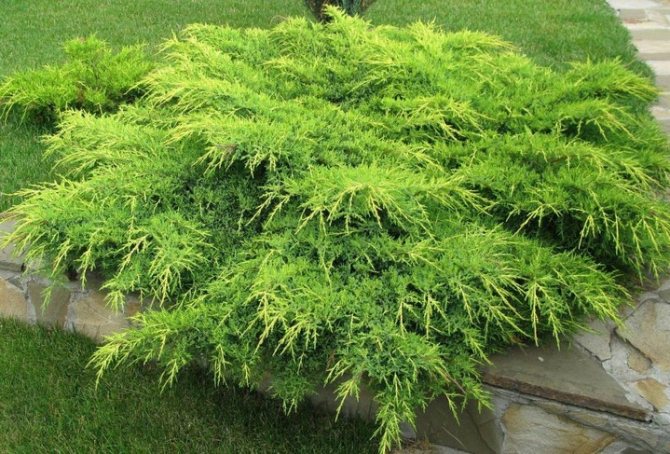

Landscape designers include trees with exotic needles in different garden groups:
- Slides and slopes;
- Rock gardens and lawns;
- Various garden compositions;
- Used for casing city streets and paths in parks;
- Create hedges;
- It has long been cultivated as a pot culture to create bonsai;
- Rocky Japanese garden.
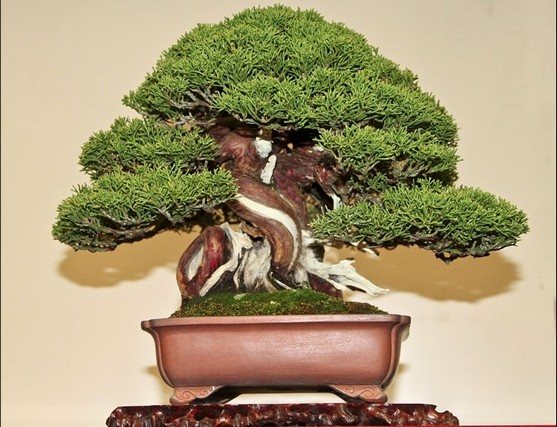

Is it difficult to grow Chinese juniper, how fast it grows and what varieties should you pay attention to.
Landscape decoration
The design of a garden space using variegat juniper can be very different. The variety is recommended for both mass plantings and compositions, and for a single location in the garden. If you plant Variegata in a composition with other varieties, then it will stand out for its variegation and refresh the appearance of the plantings.
The shrub will look advantageous next to the bushes of scarlet and burgundy roses, barberry. If the Cossack Variegata is planted under a tall coniferous tree, then such a picture will make even a compact garden plot more atmospheric and comfortable.
Experts who have been studying landscape design for a long time recommend using Variegata in places where you need to beat the slope of the earth, sharp corners or tiered compositions. Emerald needles with sun spots will perfectly hide all the imperfections of the territory, presenting it in a favorable light.
Gardeners who planted Variegata juniper at their dacha do not regret this choice. According to summer residents, the plant, although slowly, but steadily grows. Care is simple and consists in several dressings, 3-4 waterings per season and other simple manipulations. However, it should be remembered that the plant is poisonous. It is better not to purchase it for the garden, which is often visited by children.
What does it look like
Juniper Chinese, from lat. Juniperus chinensis (Cypress family), in the natural environment - a tall tree, up to 25 meters. The crown is pyramidal, conical, there are rounded, creeping shapes. A long-lived tree lives from 600 to more than 1000 years.
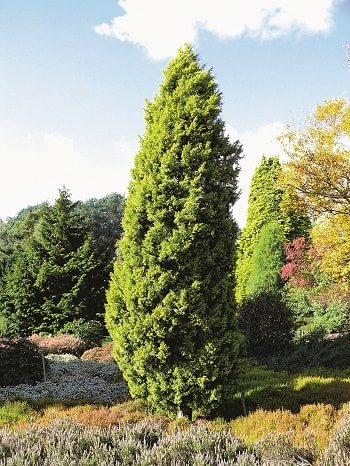

It has long been known in the Asian-Far Eastern zone - Japan, China, Sakhalin and the southern regions of the Kuril Islands. More than three centuries ago, the plant was cultivated and grows in a favorable environment for itself, both in central Russia and in European conditions.
An evergreen, long-growing shrub has needles, at first soft, which, as they grow, become tough - protruding and prickly. The needles reach a length of 12 millimeters, up to 3 of them in a whorl, and a thickness of 1 millimeter. The bark of the shoots is scaly, flaky, and has a grayish-brown color.
Fruiting rarely, has dark, bluish-black fruit-cones - round or elongated, with rounded flattened seeds inside (1-5 pieces).
Use in landscape design
The most common juniper in Western and Southern Europe, it is also often found in the mountains of the Crimea and the Caucasus, in the Mediterranean regions.
The plant is long-lived, it may look like a small shrub or a large tree.
The leaves of a young tree are like needles, an older plant has small leaves with scales. In the heat, it releases a sufficient amount of essential oils that perfectly purify the air.
Plant cones are incredibly useful. These fruits contain high amounts of sugar, essential oils and resin. They have long been very popular in folk medicine. It is necessary to harvest the fruits in the fall.
The essential oil is used for rheumatism and helps to heal wounds. Also, the fruits can be used in cooking, perfectly replace spices when cooking.
Due to the variety of species, the juniper fell in love with gardeners and landscape designers. It is often used in the design of alpine slides and stone gardens.
Low bushes will be a wonderful addition to the composition.
What you need to know to use meadow bluegrass for your lawn
as efficiently and beautifully as possible. Features of sowing and care in our article.
What are the functions of the patio in the country? Tips for arranging a recreation area, the selection of decor, furniture and other nuances.
In addition, they can be placed along paths and curbs. Tall trees are usually planted in the background, they create a beautiful and original background.
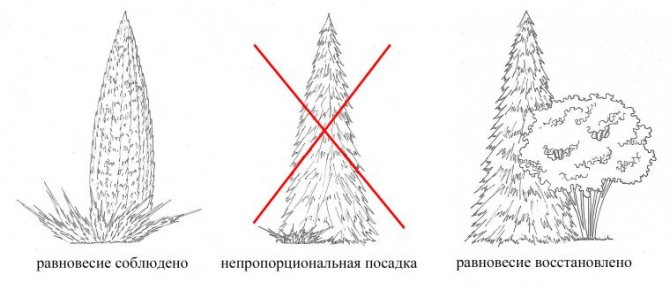

Also, do not forget that not all flowers tolerate the neighborhood with a juniper. Some varieties of roses, clematis and peonies should not be planted next to the plant.
ul
What are the features of agricultural technology
Many varieties of Chinese juniper have similar requirements for growing conditions:
- Slowly growing, growing by 10-20 centimeters per year;
- It takes a long time to take root, 2-3 years;
- The soils are different, from poorly fertile to rich in humus. I like deep digging;
- Loves lighted places, does not tolerate dry soil and air, responsive to sprinkling of the crown;
- Cold-resistant, this quality is better manifested in an adult state. It is better to cover young bushes in the first year or two for the winter. Frozen branches are pruned in spring, removing dried, yellowed shoots;
- Snow, after heavy snowfall, it is better to shake off;
- In early spring, the plant must be protected from the bright rays of the sun, shading with a covering woven material. Otherwise, shoots and needles may burn;
- It tolerates pruning, crown formation.
Read also: Violet diseases and their treatment, pest control
Varieties differ in crown shape, height and life span, as well as crown color.
It grows up to 3 meters in height, has a conical shape, the branches fit tightly and grow vertically. Increases in height by 15-20 centimeters annually. A shrub with bluish-green needles in winter becomes bluish-blue.
During fruiting, many brownish-purple bumps appear. Strickta likes good soil, drained areas in bright places.
The trees of this variety should be planted at a distance of up to 2 meters, since the diameter of a ten-year-old plant reaches one and a half meters.At the bottom of the pit, be sure to lay out a 20-centimeter drainage, do not deepen the root collar.
Young plants are fed once a year, sprayed in dry weather, and covered with spruce branches for the winter in the first two or three years. The shrub is not too hardy. Also in winter, when snow is sweeping, branches can break from its severity. Prevent this by tying the shoots to the trunk.
Juniper varieties Strickta are placed in single and collective plantings, they decorate Japanese rocky gardens. With a dense planting in one line, a hedge is obtained. They are combined with cotoneaster, heather, barberry and honeysuckle, mountain pine.
Representatives of this variety have a picturesque appearance, thanks to the multi-colored needles. The pyramidal shrub grows up to two meters high. The color is curious - yellowish-whitish spots on green, sometimes bluish, needles.
This variety is quite suitable for growing in central Russia, has winter hardiness.
Soil conditions: I like it so that the water does not stagnate, you need a drained layer in the planting pit and loose, moist soil. Juniper Chinese Variegata takes root for a long time in place, for 2-3 years it needs special attention and care: shelter for the winter at a young age, protection from sunlight in early spring days.
If the plant has lost its decorative effect in winter, the branches have broken, turned yellow and dried up, the affected shoots are pruned in the spring. Pruning is well tolerated by the tree - it will soon be completely restored.
The variegated color scheme will make the design of any garden, park and composition unique. This variety is cultivated as a pot culture. A unique, original ensemble is obtained from conifers and other trees and shrubs placed next to each other, which have a bright, spectacular appearance.
Stricta Variegata
The golden creamy patches against a green, bluish background are a magnificent variegated juniper variety.
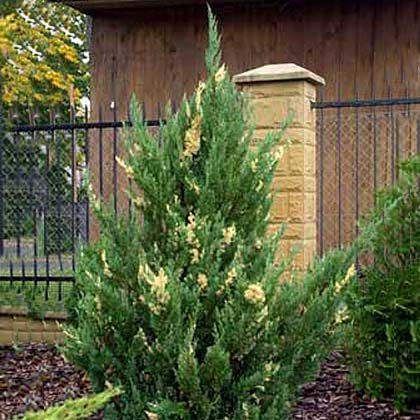

He has a cone of irregular shape, tight-fitting branches, grows up to 3 meters up, crown girth is more than 1.5 meters. It grows, like all varieties, slowly, which must be taken into account by those who wish to get a tall, lush tree in a short time.
Loves sunny places, a little partial shade. In the shade, however, it becomes oppressed, decorativeness is sharply lost. Fruiting in cones of dark brown color with a purple tint.
A frost-resistant variety, the requirement for soils is looseness and moisture permeability. By planting this bush in your garden, you can create an exquisite, original style of the site.
Landing
Elderberry black Aurea: description and characteristics of the variety
The plant is usually planted with seedlings. There is a variant of seed propagation, but this process is too complicated. It provides for long-term stratification. It is best for a summer resident to buy a high-quality Cossack Variegat juniper seedling. The recommendation for the age of the planting material is 3-5 years. Seedlings are sold both with a closed root system and with an open one. Planting can take place both in spring and autumn. The soil should be moderately warm, moist. Variegata grows best in open areas with ample sun. In the shade, its crown becomes loose and not fluffy.
Important! Before choosing a place, it should be borne in mind that the plant will grow in width. The culture should be given enough free space. Plants are planted at a distance of 1.3-1.8 m from each other.
Detailed instructions:
- The garden bed, which will be decorated with juniper, can have any soil. Variegata is not whimsical. However, it shows the best growth on fertile, light, loose soils, where there is enough turf, peat and sand. The acidity should be neutral.
- If the root system is closed, then the root is removed from the container and placed in a bucket of water for several hours. Next comes the treatment with a growth stimulant.
- A large hole is dug for a seedling - about 40-65 cm in depth and 30-60 in width, depending on the size of the planting material. A drainage layer is laid at the bottom. It is allowed to be made of rubble, stones, broken bricks. A pillow of ordinary sand is poured on top. A seedling is placed on it.
- There is no need to bury the plant in the ground. The gardener needs to make sure that the root collar is visible and is just above the ground.
- After the planting is completed, the near-trunk circle is spilled with water.
- If the planting was organized in the fall, then for the winter the young plant is covered with non-woven material.
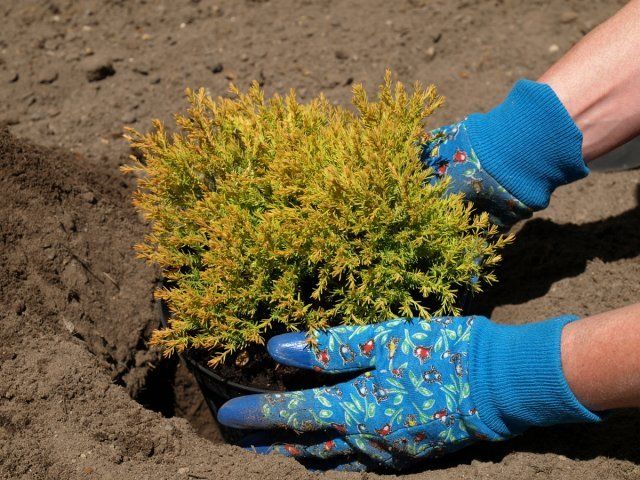

Juniper planting
Growing juniper from seeds
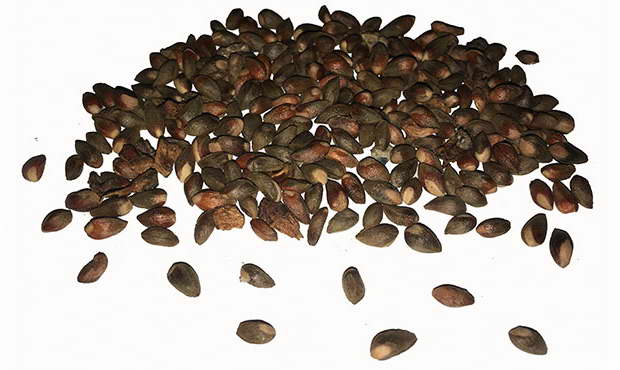

How does a juniper breed? Most often, seedlings are purchased in nurseries, but if you wish, you can propagate the juniper yourself. Creeping bushes are propagated by layering, other forms are also propagated by green cuttings, seeds.
- Before planting, it is better to stratify the seeds: place them in a box with soil, cover them, take them out into the garden, where they should spend the whole winter.
- Sow outdoors in May.
- Without prior stratification, the seeds will sprout next year.
- Seeds with a very dense shell must be scarified - damage the shell mechanically (rub with sandpaper, break through the shell with a needle).
- The seeding depth is 2-3 cm.
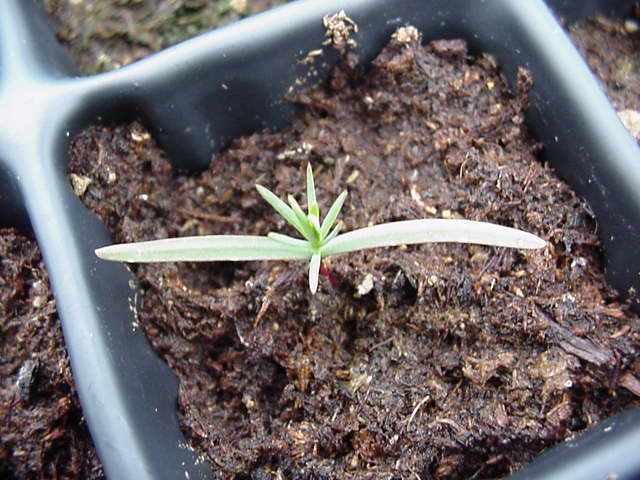

- Water, mulch the soil, cover with a bag or a transparent lid to speed up seed germination, do not forget to ventilate.
- After the appearance of the first shoots, the cover is removed, the seedlings are protected from direct sunlight for the first couple of weeks.
- Loosen the soil regularly, weed from weeds.
- Transfer seedlings 3 years old with an earthen clod to a permanent place of growth.
ul
Description and varieties of plants with photos
In nature, there are trees twenty meters in height. Evergreen coniferous junipers are found in China, Korea, Japan.
The plant is not very diverse. The most common and presented in the photo are the types:
- Spartan;
- Obelisk;
- Strict;
- Mint Julep;
- Old Gold and some other species.
Fact. Unpretentious plants live a long time and do not lose their decorative effect.
According to the description of the ancient Slavs, the juniper is a symbol of eternal life.
Blue Alps
Juniper of this variety is one of the most common conifers. It has a spreading crown in the form of a wide pyramid.
Blue Alps grows slowly, in 10 years it reaches an average of 2 m. An adult tree does not exceed 4 m. The needles are prickly, protruding, silvery-green. Skeletal branches have drooping ends.
Juniper has a strong root system. The shrub can grow even in marginal soil with neutral or low acidity. Good lighting is a must.
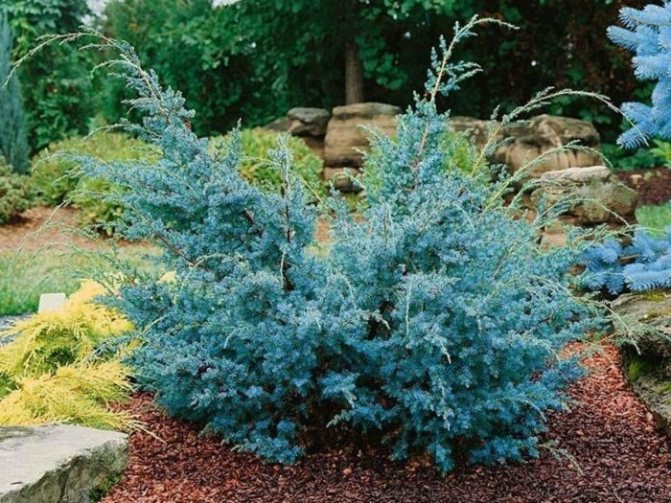

Blue Alps adapts perfectly to urban dusty conditions. It is also frost resistant.
The bush looks good in a group with other low-growing plants, especially roses. It will serve as an excellent decorative background for flowering perennials.
Spartan
Juniper Spartan has a fluffy crown in the form of a cone. Pruning only enhances its splendor. By the age of 10, Spartan grows up to 3 m, and subsequently up to 5 m.
The needles are scaly, bulging in some places. Spartan is used in landscaping streets and squares. With its help, hedges are made out. The dense crown allows trees to be shaped in different ways. The plant is successfully combined with other plantings.
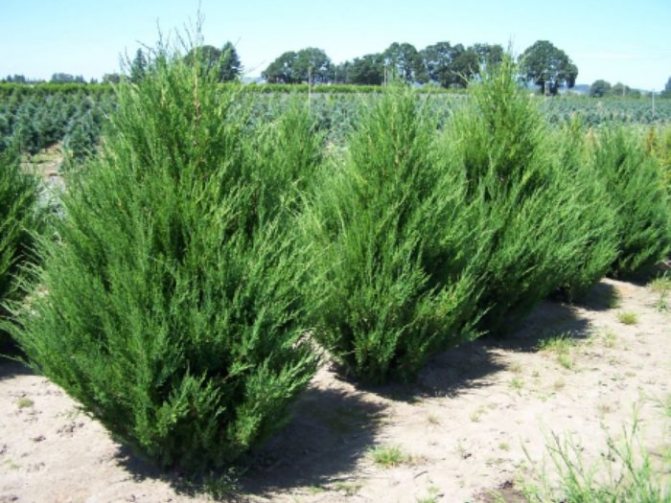

Juniper Chinese Spartan loves light, moderate humidity and neutral soil.
Obelisk
Young trees have a narrow crown. An adult plant reaches three meters in height. The obelisk has short twigs with dense needle-like needles. Below, on the protruding needles, there are silvery stripes that create a blue tint.
The obelisk is used in landscaping as follows:
- single landings;
- group landings;
- trellis;
- decorating slides and slopes.
The species is resistant to frost.A little shading is safe for him. Juniper does not need to be sprayed and tolerates drought safely.
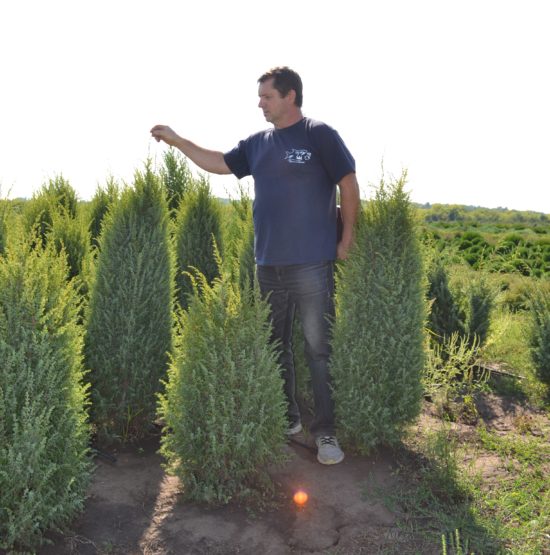

Strickta
The evergreen Chinese shrub Stricta is loved by many gardeners. It changes color depending on the season.
The plant firmly holds the soil, as it has a powerful root. This helps to contain erosion.
Young juniper Chinese Strekta Variegat should not be under the scorching rays of the sun, it can get burned.
Stricta loves slightly acidic or neutral soils. The variety does not require abundant watering. During dry periods, it is recommended to spray it early in the morning or late in the evening.
Advice. Adult Strickt juniper is hardy, but young seedlings should be covered. The circle near the trunk can be overlaid with the paws of conifers.
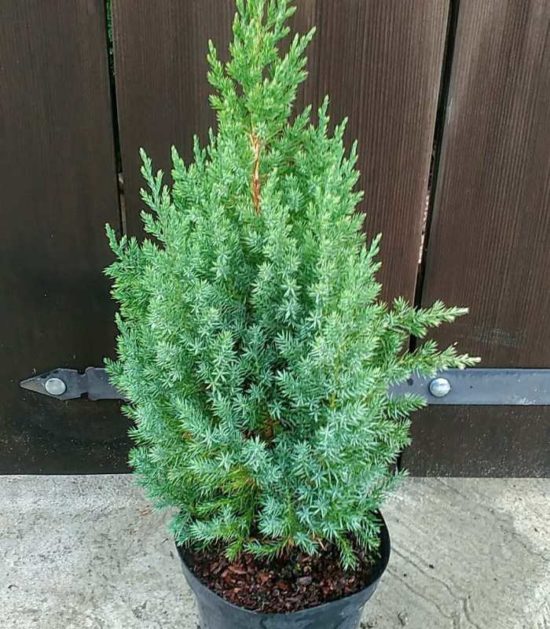

Mint Julep
The shrub has arched drooping branches. It has a spreading crown and delicate color of scaly needles.
The plant grows well in lighted areas. Calmly endure the winter cold of central Russia.
Mint Julep is planted at a distance from other crops, as it can grow strongly. Juniper looks spectacular among other conifers.
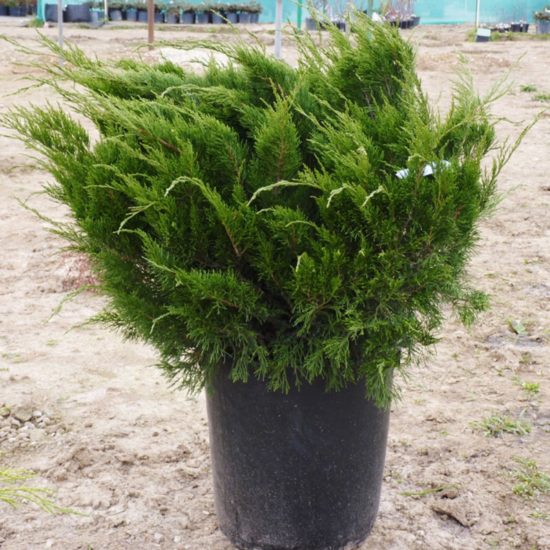

Old Gold
Dutch breeders have developed their popular varieties. The Old Gold juniper looks gracefully in the garden. It has a funnel shape. On average, it grows to a height of about one meter.
The crown of the bush is squat, fluffy, light green. The needles in the form of scales completely cover the shoots.
Old Gold goes well with other plantings, but can become an independent decoration of the site. Grows well in a container.
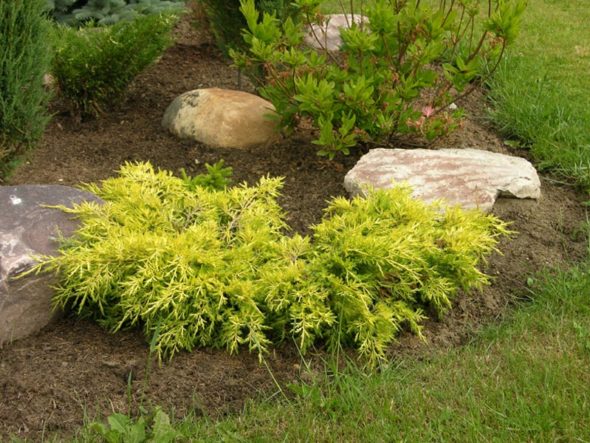

Kurivao Gold
A shrub with spreading branches is a great option for a hedge. An adult plant reaches two meters in height and takes the shape of a square.
Scaly needles are bright green. Yellow-colored young growth looks spectacular against their background. The tips of the shoots are golden, which gives the shrub a decorative effect and brightness. Juniper cones are dull at first, and then black with a whitish bloom.
Fact. Cones and needles are poisonous. Care should be taken.
Care for this variety is small, it includes:
- watering (once a week);
- top dressing (2 times a year);
- pruning (spring).
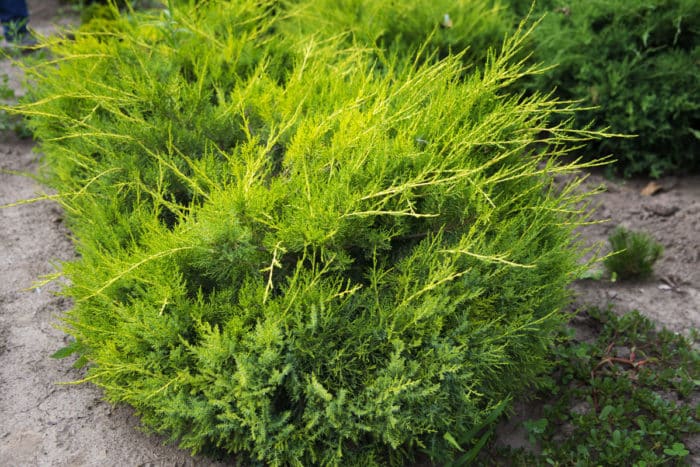

Kurivao Gold looks good in the center of floral arrangements. Growing in a pot at home is possible.
Expansa Variegat
One of the smallest varieties of the species is Expansa Variegata. It grows up to no more than 40 cm. Shoots spread in the form of a needle-like carpet.
The needles and scales are green-blue. Some of them are cream colored, which distinguishes this variety from others. The fruits are small bumps.
The plant has a very slow growth, in 10 years it grows by about 30 cm. Variegata grows well on rocky soil, spreading in different directions. For this reason, it is not recommended to plant it at home, but if you really want to, then you should choose a wide pot.
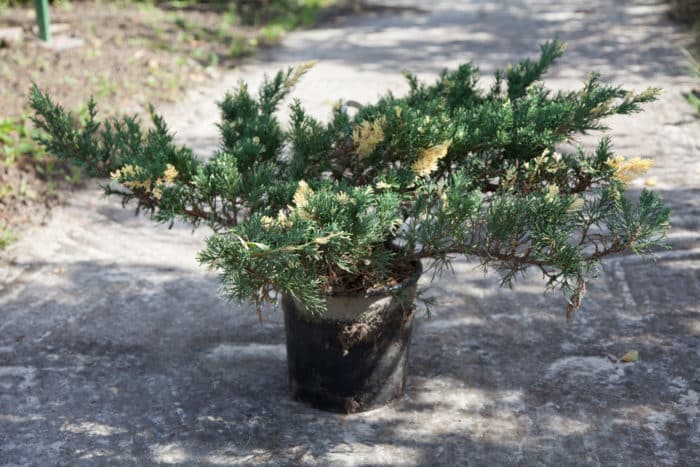

Blau
This evergreen shrub with slow growth is loved by the Japanese. They use it to decorate gardens and flower arrangements. The needles of the plant are scaly, gray-blue. Straight shoots give it a crown shape. Blau grows up to 2.5 m.
Like other varieties of juniper, it is not whimsical to the soil. The plant adapts well to polluted air and toxic emissions.
Better to plant Blau in partial shade. It looks especially good in the company of high decorative crops.
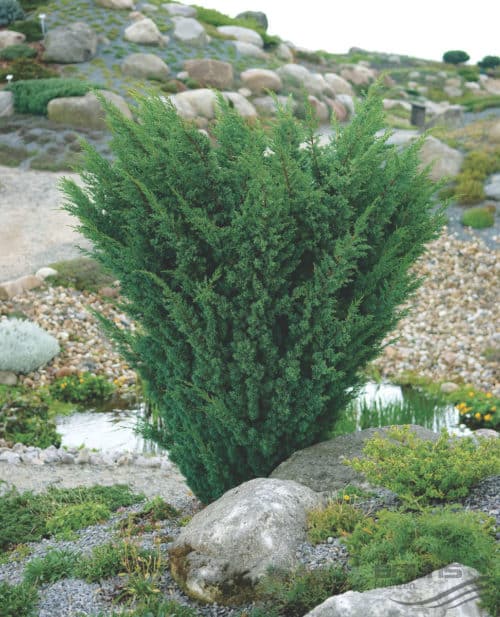

Advice. Do not let the water stagnate for a long time, otherwise the juniper can rot.
Plumosa Aurea
The dwarf shrub grows rapidly, every year it is added by 20-25 cm. The feathery shoots look attractive. With proper care, Plumosa Aurea will stand out effectively from other ornamental crops.
Soft needles with small scales are yellow-golden in color in illuminated places. With a lack of sunlight, they turn green.
The variety will grow on any type of soil, but moist, fertile soil will improve its growth and development.
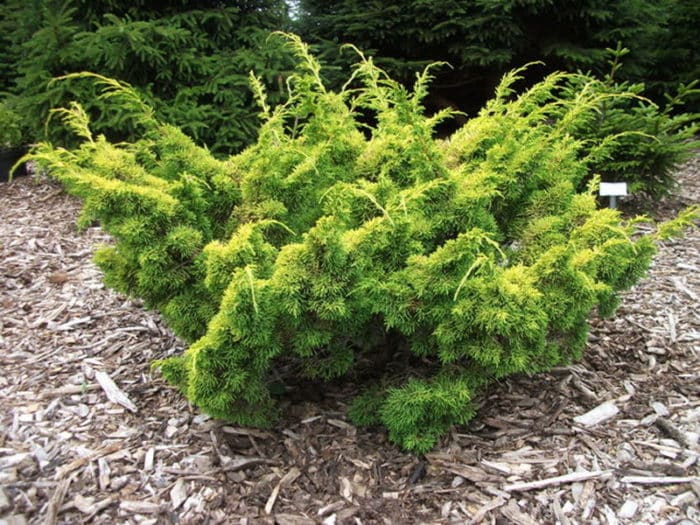

Monarch
The shrub has an irregular column shape. Its maximum height is 3 m. The Monarch grows slowly.
The needles are dense, green-bluish. The plant is well suited for green hedges. It will also look spectacular as the centerpiece of the garden. It can be planted in the sun and shade.
The monarch purifies the air, collects dust. I plant the plant in alleys, parks, lawns.
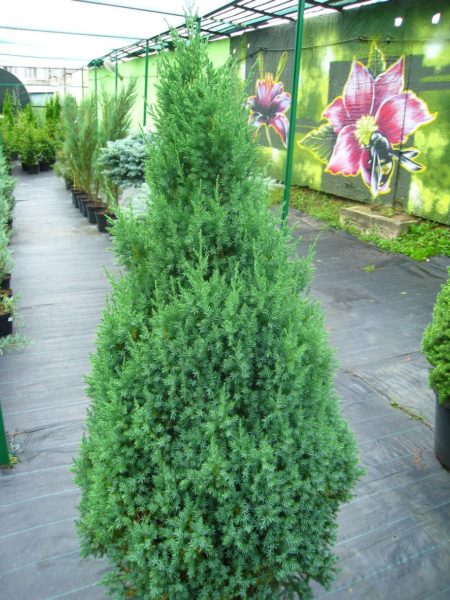

Place in the garden
You can and even need to use Strickt juniper in the design of your site. Reviews of landscape designers about this plant are positive, due, first of all, to unpretentiousness to soil, watering, cold resistance and high decorative effect. With a developed and strong root system, the juniper will hold the soil well - this can be used to prevent erosion in certain areas.
The landscape application also depends on the variety. If you choose high varieties, then they will look great both in group plantings and singly. Juniper Strickt is used in single and heather plantings. Creeping forms are good for use on alpine slides or rockeries. Shrub forms are suitable for creating a hedge. All junipers look good in group planting with other conifers, for example, dwarf, mountain pine or Christmas tree.
Briefly about culture
Junipers are a group of evergreen plants from the cypress family. Most of the species are compact shrubs, but there are also quite tall trees (up to 4 m). Leaves are small needles from 1 to 1.5 cm long, collected in bunches. They last up to 4 years.
Common juniper has medicinal properties. The rest of the forms serve only decorative functions.
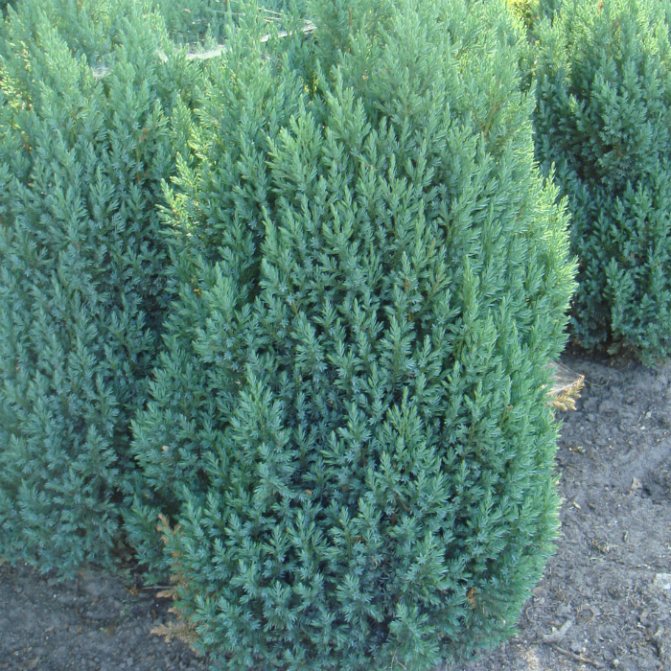

Juniper stricta chinese
Growing problems
When growing Stricta, it is possible to observe yellowing and falling of the needles. First, a small area is affected, then the remaining parts turn yellow and die off. The cause may be a fungal disease. The affected branches will have to be cut off, and the sections should be treated with a 1% solution of copper sulfate.
Loss of decorativeness can come from an excess of light and a lack of moisture. Young seedlings are especially prone to burning. To protect them, at the beginning of spring, the crown is covered with spunbond or other material. Shading during hot hours should be considered when planting shrubs in an open place. With the onset of spring, the soil can be warmed up with warm water. Another possible cause is a lack of potassium and nitrogen.
Video about the features of care.
Withering can cause a fungus of the genus Fusaria. First, the roots are affected, they change color and become covered with gray spores. The fungus then spreads along the trunk and branches. When dying shoots are found, they are cut, the soil is treated with fungicide. You can buy Topaz, Gamair or Alirin. If possible, replace the soil around the bush.
- Juniper tick attacks
A common pest is the juniper mite. This insect settles on the roots and feeds on the sap of the plant, causing it to wilt. You can determine the infestation with a tick by the soil: it remains moist for a long time, since the roots lose their ability to absorb. Pest remedy - acaricide solution. They need to water and spray a prickly dwarf at the first sign of a juniper mite, otherwise it will die in a few weeks.
Planting and leaving the miniature Strickt ephedra is a simple exercise that even a gardening neophyte can handle. Growing conifers is attractive not only for its simplicity, but also for the benefits that the seedlings carry in themselves. Chinese juniper on the site is a guarantee of an aesthetic appearance and a healthy atmosphere.
Juniper care at home
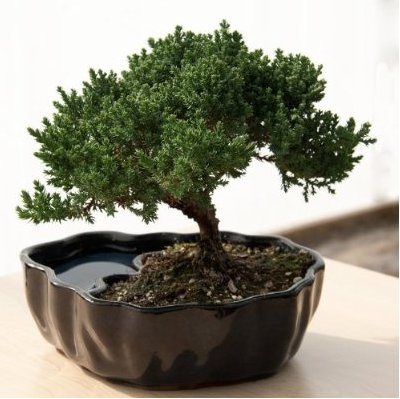

For growing at home, Chinese and hard juniper is best suited.
How to plant
Plant young seedlings in spacious pots with nutritious soil (turf, sand, peat, add nitrophosphate). Be sure to lay drainage at the bottom of the container.
Lighting and air temperature
Lighting is required bright, but protected from direct sunlight.
The optimum air temperature for normal growth is around 25 ° C. It is better to keep it cool in winter - about 15-20 ° C.
How to water
Water sparingly: do not allow the earthy clod to dry out, drain excess moisture from the pan. In the warm season, spray the plant every day 1-2 times a day, in winter - 1 time every 2 days. Ventilate the room regularly.
How to feed
In the period April-September every 2 weeks, along with watering, apply mineral fertilizers in a concentration of 1 to 5. Sprinkle humus as a fertilizer.
Pruning and replanting
Perform sanitary and formative pruning in the fall.
Repot annually in the spring using the earthen ball transfer method.
Diseases and pests
Juniper is resistant to diseases and pests at home. If the needles turn yellow and begin to die off, it is necessary to cut off the affected areas with a disinfected pruner and treat it with a fungicide.
ul
Diseases and pests
Juniper can be killed by fungus. The roots turn black, water cannot move through the vessels, the bush dries up. This disease is not treatable, the plant will have to be destroyed.
Brown nubs on the branches should be immediately cut off with a disinfected sector, this is rust. Black bloom on the needles is a sign of Alternaria. The disease arises from the thickening of the plantings. The affected bushes are removed.
Insect pests can cause certain problems to the plant. Especially dangerous:
- angle-winged moth;
- shield;
- gall midge;
- lobeed;
- red ants.
When attacked by the moth and scabbard, the plant withers and dies. The bush and the adjacent soil are processed.
Juniper Lyubate makes moves in the bark. The plant is treated by burying Fufanon or Actellik in places where insects accumulate.
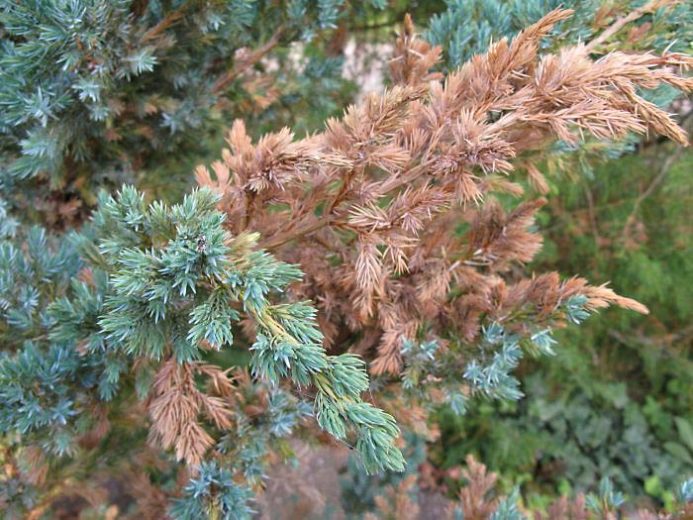

Transplanting adult plants requires skill and dexterity, so gardeners are advised to buy young shrubs. They are transplanted together with an earthen lump, which is abundantly moistened with water two hours before planting.
Before pruning a bush, you need to think through everything, otherwise you can ruin its appearance. There are special tools for this procedure.
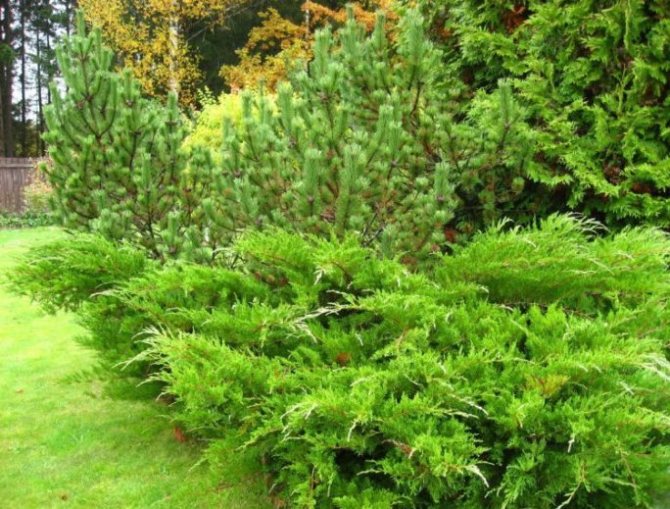

Breeding methods of juniper strict
This variety of juniper can be propagated in two ways: from cones and cuttings. Let's consider them in more detail.
- Seeds. This is a rather complicated and lengthy process. First, it is necessary to collect the berries in summer or autumn, then they are mixed with wet sand and kept at room temperature. Then for another 4 months they need a temperature of 15-16 degrees. In the soil that you will use for sowing seeds, you need to add soil from the root of the growing juniper. You need to sow seeds in boxes in which drainage is created.
- Cuttings. This method is the most common and gives quick results. Cuttings are cut in mid-summer from the top of the crown. The lateral processes are removed and the bark is cut off from the lower part. Such branches need to be rooted in a semi-dark place, which is covered overnight. The soil for this is used from a mixture of peat and juniper needles. Gradually accustom the plant to light. After final rooting, the juniper can be replanted.
Characteristic
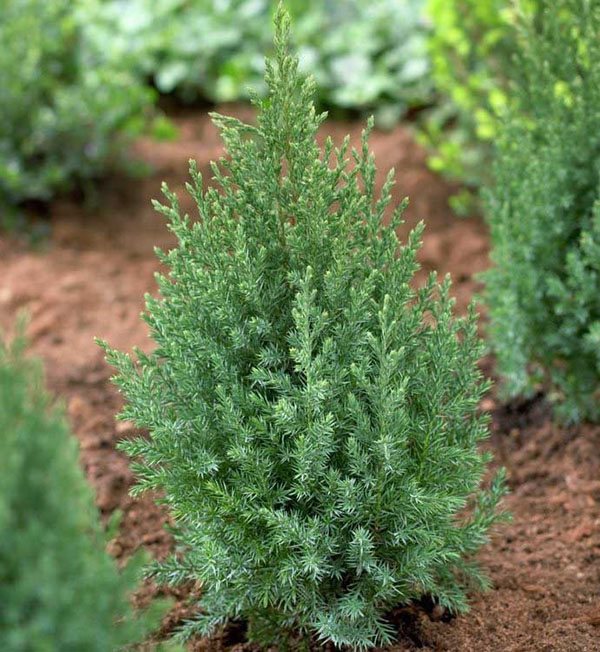

The description of Strickt juniper makes it possible to study the variety even before going to the nursery for a seedling.
The plant is considered a dwarf tree, its growth reaches 2.5 meters. The diameter of the juniper is 1.5 meters. The tree has a lifespan of about 100 years. It is appreciated by Russian gardeners for its endurance and frost resistance.
Straight and thin branches are densely and evenly distributed on the sides. They grow upward at an acute angle.The crown of the tree is even and dense, conical in shape. The needles are sharp and not rigid, of a delicate bluish tint. Such a juniper bears fruit with cones with a dark blue waxy bloom, which give the tree a picturesque look.
Wintering
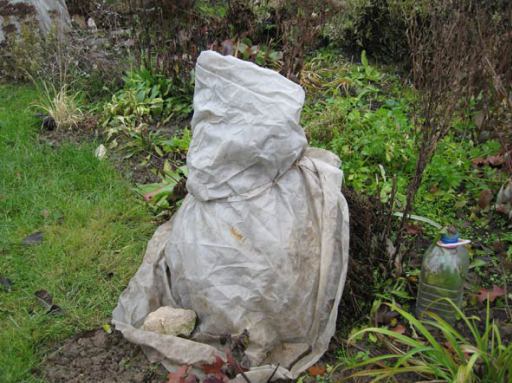

With the onset of return frosts in the fall, the plant should be mulched abundantly with peat with a layer of 10 cm or more. In the north, the juniper should be covered with spruce branches, agrofibre or non-woven material. If you grow it in a container, then from the second mid-September, the plant is brought into a cool room with moderate humidity and a temperature of 8 to 10 ° C. During the entire period of rest, the soil moisture should be monitored, periodically spraying with a spray bottle.

